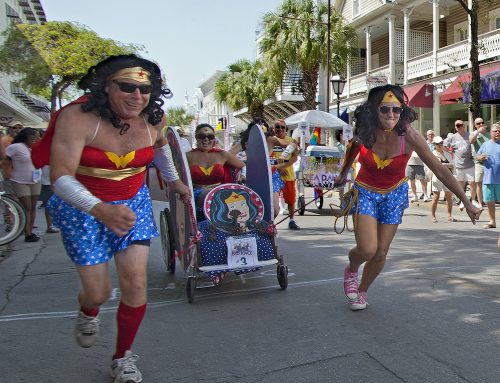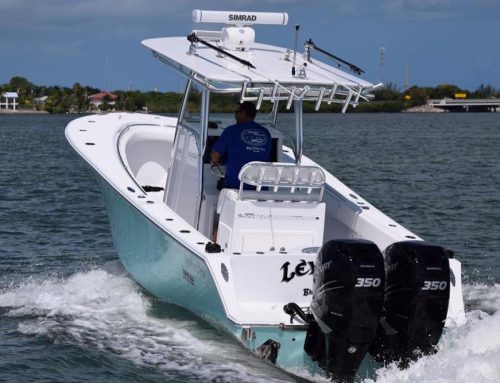In the Florida Keys, the continental United States’ only living coral barrier reef lies just a few kicks from the surface — a paradise for underwater enthusiasts looking for shallow, easy reef diving.
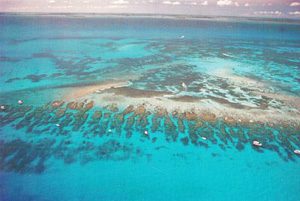
The one-of-a-kind Looe Key Reef, an underwater wonder, lies about 6 miles south of Big Pine Key in the Florida Keys National Marine Sanctuary.
Divers exploring Lower Keys waters can thank the crew of the British frigate H.M.S. Looe for one of the most beautiful shallow reefs to be found. Why? Because the Looe ran hard aground in 1744, lending its name to a reef that’s like no other in the Keys.
Looe Key has been federally protected for more than 35 years, with prohibitions on spear or surface fishing and shell collecting.
In this intriguing area, divers and snorkelers can explore a variety of structures. Patch reefs and spur and groove formations range from 5 to 35 feet, appealing to both novices and those with advanced experience.
Perhaps the greatest diversity of fish species in the Keys is found among the corals and sea fans of Looe Key. From Florida Bay, snook and permit can be spotted — while arrow crabs, trumpet fish, brittle stars and the usually rare octopus also can be found in nooks and crannies. Even sea turtles occasionally make a curious pass through.
Each year in July, divers and snorkelers gather at Looe Key Reef during the Underwater Music Festival, a subsea concert that promotes reef protection.
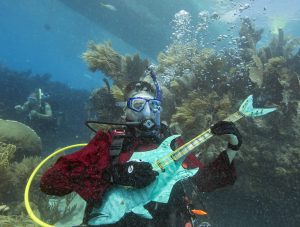
Mike Limerick pretends to play an artist-created musical instrument at a Lower Keys Underwater Music Festival. (Photo by Bob Care, Florida Keys News Bureau)
“The festival is a way to celebrate the coral reef, and we celebrate it by looking for a balance between protection of the reef and public enjoyment,” explained festival co-founder Bill Becker. “The more people realize what’s down there and enjoy it, the more they’re likely to protect it.”
Easily accessible and not far from the spectacular underwater beauty of Looe Key Reef and American Shoal, southwest of Big Pine Key, is the largest wreck available for sport diving in the Lower Keys.
The 210-foot Adolphus Busch was intentionally sunk Dec. 5, 1998, in 112 feet of water. At that time, it was the Lower Keys’ first artificial reef and the first ship purposely scuttled as a Florida Keys artificial reef in 10 years.
The process was accomplished by drilling 12 holes for water to pump into the vessel’s hull and sink it. It settled upright and in perfect condition on a sandy bottom, with its wheelhouse at 70 feet and its main deck at 90 feet.
Hatches and portholes were removed, but the ship remains otherwise intact. The 12 large holes provide safe, easy access into it.
Built in Scotland in 1951, the short-haul island freighter was previously called the London, Topsail Star, Windsor Trader and Ocean Alley. It was christened Adolphus Busch Sr. by the Anheuser-Busch brewery founder’s grandson, Adolphus Busch IV, an avid diver and fisherman.
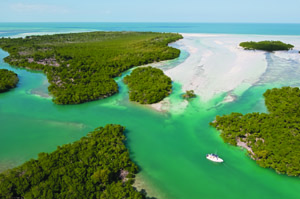
The Lower Florida Keys, home to two national wildlife refuges and a portion of a national marine sanctuary, are surrounded by a marine environment filled with abundant life. (Photo by Andy Newman, Florida Keys News Bureau)
According to members of the team that spearheaded the sinking, Busch IV wanted a permanent memorial to honor his grandfather — who originally entered the United States from Germany via Key West — that would benefit both the environment and the Keys community.
Now, nearly 20 years later, it’s clear that he succeeded in his purpose.
Recently on the Busch, divers with Looe Key Dive Resort captured video with huge southern stingrays, reef sharks and massive schools of tarpon populating the wreck.
Below schools of baitfish, 250- to 450-pound goliath grouper guard a colorful spectrum of snappers, amberjacks, grunts, blue runners, barracuda, sharks and massive schools of juveniles.
For everyone who loves the underwater environment, diving or snorkeling the enticing Lower Keys is a must-do experience. To find out more about it, just click here.




